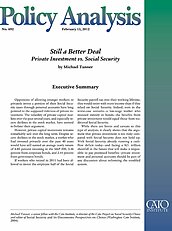However, private capital investment remains remarkably safe over the long term. Despite recent declines in the stock market, a worker who had invested privately over the past 40 years would have still earned an average yearly return of 6.85 percent investing in the S&P 500, 3.46 percent from corporate bonds, and 2.44 percent from government bonds.
If workers who retired in 2011 had been allowed to invest the employee half of the Social Security payroll tax over their working lifetime, they would retire with more income than if they relied on Social Security. Indeed, even in the worst-case scenario—a low-wage worker who invested entirely in bonds—the benefits from private investment would equal those from traditional Social Security.
While there are limits and caveats to this type of analysis, it clearly shows that the argument that private investment is too risky compared with Social Security does not hold up. With Social Security already running a cashflow deficit today—and facing a $21 trillion shortfall in the future that will make it impossible to pay promised benefits—private investment and personal accounts should be part of any discussion about reforming the troubled system.


